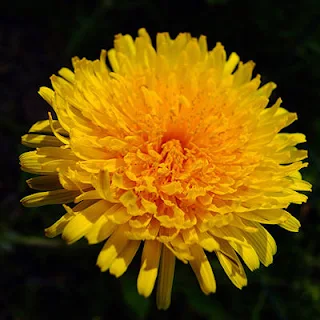How to Grow Dandelion (Taraxacum officinale)

The distinctive flowering head (or seed head) of the dandelion may be a call to battle in the garden, but it doesn't have to be that way. Dandelion can be used in a number of culinary and herbal preparations, so having a little cultivated patch of this common plant could make good sense. You won't have trouble growing it, and once its taproot is deep in your soil, you'll definitely have a regular supply. Don't scoff; the little dandelion may surprise you. Read on.
I'd usually recommend harvesting dandelion from your lawn in spring -- or from the neighbors' lawns (city tree lawns, open fields, city parks and cracks in roadway asphalt wide enough for an ant to pass), but those sources may be tainted with pesticides and other nasties you don't want to deal with. No, with hardly any effort you can cultivate this useful and fun flower in its own dedicated spot. Here are some examples of what the lowly dandelion can be used for:
- Dandelion wine - Delicious
- Dandelion salad - Who says you have to pay exorbitant prices for arugula and other bitter greens when dandelion is the real deal.
- Dandelion smoothies - They're rich in vitamins, minerals and antioxidants
- Dandelion tea - This brew may reduce blood pressure, reduce blood sugar, aid in digestion and help control premenstrual cramps.
 |
| Look at the leaf in the center for a gander at the toothy indentations. |
How to Grow Dandelion
The dandelion, a European native, will thrive in most conditions, but plants grown in a shady spot will tend to be less bitter. You might also take a look at the newer dandelion cultivars on the market instead of going for "wild" stock. Some dandelion cultivars are less bitter than others, which will makes using them more appealing. These are typically sold as "gourmet" seeds or plants. Many have quasi French names. Other reliably mild types include Arlington dandelion and broad leaf dandelion (improved).
Dandelion Maintenance
For most of the herbs I talk about, getting them to thrive is the biggest consideration. With dandelions, keeping them in check is a bigger concern. Because they're very invasive, take a few measures to corral them in a spot away from your lawn. It's also important to remove the flowering heads before they transform into "wish worthy" puff balls. Those interesting spheres are actually seeds -- lots and lots of adaptable, windblown seeds.
 Growing dandelions in a pot is an option, but because the plant has a long taproot, this can be challenging. You'll need a deep pot (12 inches).
Growing dandelions in a pot is an option, but because the plant has a long taproot, this can be challenging. You'll need a deep pot (12 inches).Investing in a taproot digger or dandelion digger is a good idea, too. These tools have a sturdy handle, a long shaft and a forked tip that can get to and extract roots of unwanted plants -- and harvest roots for tea and other medicinal preparations.
Harvesting and Using Dandelion
Although all parts of the dandelion can be used, the leaves are best harvested when the plant is young and tender (and less bitter). This will be before blossoms appear.
If you're determined to harvest dandelions from locations other than your landscape, use some real caution. Avoid areas where you notice dumping (vacant lots), or discolorations in the soil. Don't harvest plants near roadways because lead and other chemicals from vehicle exhaust may be present. Note: You can gather dandelion flowers in batches and freeze them until you need them for winemaking and other projects.
Dandelion Nutrition
If all this seems silly and risky, dandelion hunting or cultivation is worth the effort. This plant is a nutritional powerhouse, rich in:
- Calcium
- Copper
- Fiber
- Iron
- Magnesium
- Manganese
- Phosphorus
- Potassium
- Riboflavin
- Thiamin
- Vitamins: B1, B2, B6, A, C, E, K

Dandelion is high in protein. (It also contains all the essential amino acids, which is a bit of a feat in itself.)
Here are a few past posts about fun things to do with dandelions:
Dandelion Tea Recipes
Dandelion Salad Recipe
How to Make Dandelion Wine
Dandelion Jelly
-------------------
Photo1 - Dandelion1_Wiki.jpg By Nicolas Zea P. (Own work) [GFDL (http://www.gnu.org/copyleft/fdl.html) or CC-BY-SA-3. http://upload.wikimedia.org/wikipedia/commons/0/00/Dandelion_02.jpgPhoto2 - Courtesy of Morguefile.com
Photo3 - Dandelion2_Wiki.jpg By Sberardi (Own work) [CC-BY-SA-3.0 (http://creativecommons.org/licenses/by-sa/3.0)], via Wikimedia Commons
Photo4 - Dandelion3_Wiki.jpg By Audrey from Central Pennsylvania, USA (Frosty Dandelion Uploaded by Fæ) [CC-BY-2.


I thought the trick was not to grow dandelions! I have sampled the greens and the wine.
ReplyDeleteWow! Who knew?!
ReplyDeleteHow marvelous of you to publish more information on my favorite flower, herb, edible, tea, facials, alcoholic beverage, vegetable, medicinal, etc. The Dandelion has been a favorite of mine since a small girl, watching little bunnies eat off them in the early Spring mornings, through my bedroom windows. My mom, pulling them from the grass when she had time, exasperating my joyous times looking at the delicate flowers with the hares, up until the present time when I can hardly wait to see what kind of crop this season brings for dandelions. Less rain has decreased the crops in South Texas, however I am still looking for them. Plus, I will be ordering seeds for the next season and watching for the blooms in my own back yard. I am willing to give them the entire yard; well, almost. I do have wild peppers I like to keep growing, and I am looking forward to planting a crop of Saffron bulbs in September for my own Saffron threads to season breads and pudding. Hopefully, that is!
ReplyDeleteThank You, thank you, and I thank you, georgia
Have anyone tried growing dandelions using the aquaponics system?
ReplyDelete